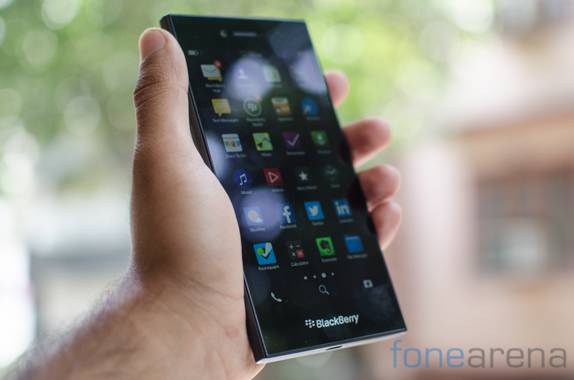 From the ultra-lux BlackBerry Passport to back to rediscovering their strength with the Classic, the Canadian smartphone company has stuck to keyboard toting hardware in the recent past with the last all touch device being the BlackBerry Z3 back in 2014. Jump forward an year and we have the brand new BlackBerry Leap. A handset that brings subtle hardware improvements all around and takes aim to become the go to handset for BlackBerry aficionados looking for an upgrade. Having spent some quality time with the hardware, here’s our review of the all new BlackBerry Leap.
From the ultra-lux BlackBerry Passport to back to rediscovering their strength with the Classic, the Canadian smartphone company has stuck to keyboard toting hardware in the recent past with the last all touch device being the BlackBerry Z3 back in 2014. Jump forward an year and we have the brand new BlackBerry Leap. A handset that brings subtle hardware improvements all around and takes aim to become the go to handset for BlackBerry aficionados looking for an upgrade. Having spent some quality time with the hardware, here’s our review of the all new BlackBerry Leap.
Design
The BlackBerry Leap has a utilitarian design that is in many ways identical to the Z3. There are subtle changes and while the phone probably wouldn’t win a design award, it is certainly not an eyesore. Amongst the sea of iPhone clones, here is a handset that stands apart while being confined within the restrictions of a large screen and minimal bezel area.
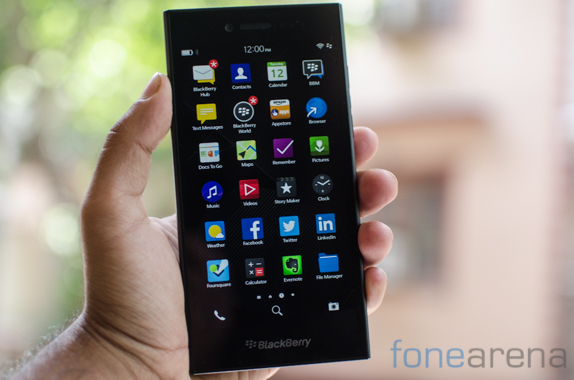
The front of the phone houses a 5 inch 720p display flanked by large bezels on top and bottom. Above the display is where you’ll also find the front facing camera and the proximity sensor flanking the earpiece alongside a bright notification LED. Below the display lies a rather large BlackBerry logo. An extremely subtle rim runs along the front edge of the handset that gives the phone a very slight lift to aid in preventing scratches. This however does mean that you can’t just seamlessly slide in your finger onto the screen from the edge of the device. This, as you’ll realise is rather essential for the gesture heavy BlackBerry OS.
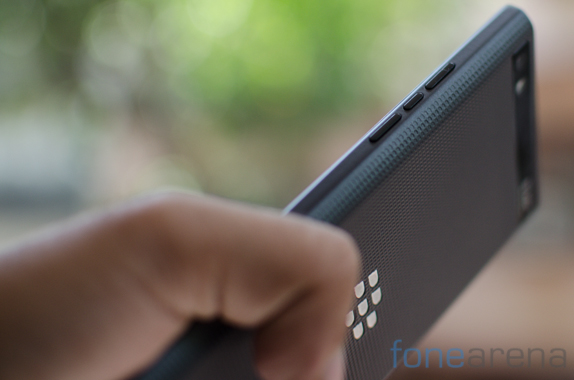
Towards the right of the handset are separate keys for volume up and down while between them is a mute key. Long pressing this key activates BlackBerry Assistant which is the company’s take on Siri and Cortana, just not as good. Moving over to the left side, you’ll find the microSD card slot as well as the nanoSIM tray hidden under a single flap. The flap is surprisingly rigid and fits very snug with the rest of the body so we’re fairly confident that it’ll be able to keep dust and other grime out of the handset.
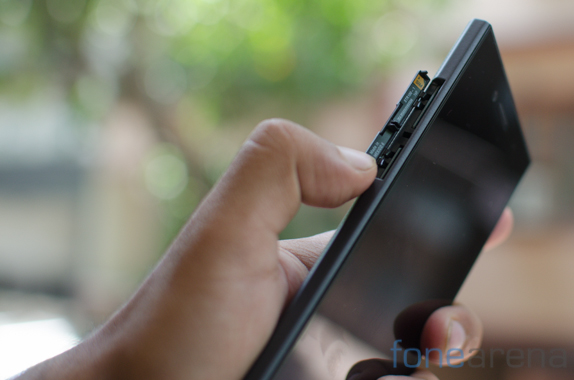
The rest of the port configuration is bog standard and you’ll get a 3.5mm audio jack at the top while a microUSB port is placed at the bottom. Unlike recent BlackBerry handsets, the microUSB port is not SlimPort compliant so you can’t output video over HDMI through that. Additionally, the phone does not support USB On The Go (OTG) either.
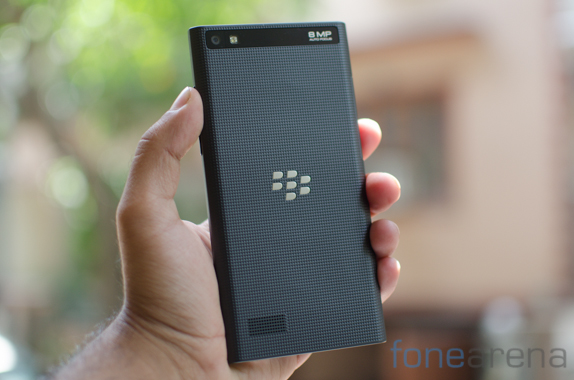
Over at the back of the phone is where things get interesting. The Leap employs a unique rubberized mesh like finish that makes the handset very grippy. Suffice to say that there’s next to no chance that this device will slip out from your hands. Not just grippy, the BlackBerry Leap also gives the impression of being a very sturdy device.
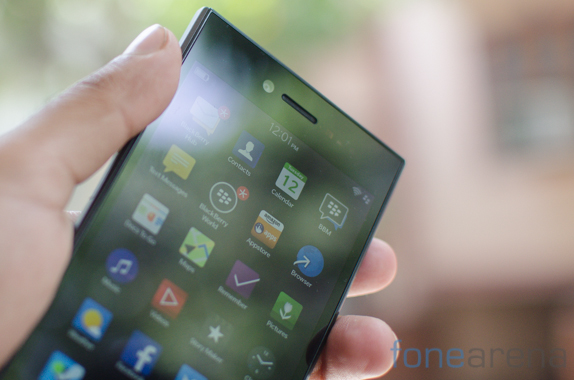
Polar opposite of the svelte and slim, dainty designs of most current high end devices, the Leap makes sure you know that this one can (probably) take a beating. The phone is pretty heavy at 170 grams and is positively huge at 144 x 72.8 x 9.5 mm with a screen to body ratio of just 65.7%.On the whole, the BlackBerry Leap is a very well built handset that packs a design language that speaks mid level manager more than aspiring fashion model but as we’ll find out further in the review, this is perhaps exactly what the company aimed for.
Software
Blackberry’s latest leaps onto the newest version of their QNX based operating system ie OS 10.3.1. If you’ve used any modern BlackBerry handset then you’ll feel right at home with the Leap. The software navigation is a relatively standard affair involving swiping through panes and using gestures to close or minimize apps.
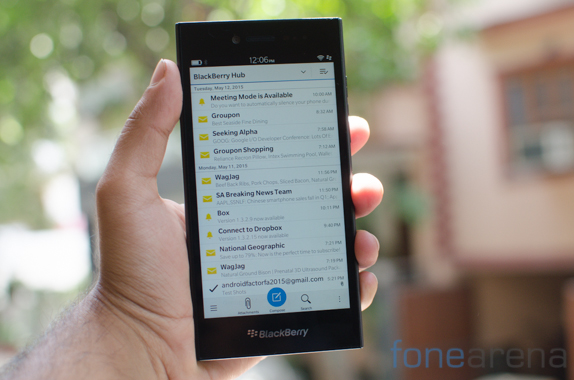
In case this is your first experience with BlackBerry OS, you’re in for a bit of a learning curve. Unlocking the phone, you just see a plain lockscreen that has your calendar information, time and any recent notifications listed out. Swipe up and you’ll be dropped into the homescreen that also serves as the app grid. Swipe over to the BlackBerry Hub and you’ll find all your communications and notifications grouped together and presented in a neat way. Being actionable, you can then reply to your WhatsApp messages, Archive emails or any other action you might feel appropriate.
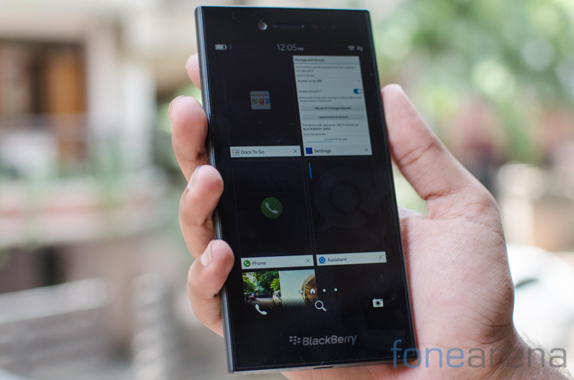
As we mentioned earlier, BB OS is very heavy on gesture usage. You’ll have to swipe up from the bezel to send a running app into the background. This brings up a window like app switcher. All running apps will be visible here and will on occasion show live information too. You can now switch between apps or even close them.

Additional features that set the operating system on the BlackBerry Leap apart from the competition include BlackBerry Assistant and Blend. The former is yet another Siri or Cortana clone and it works just about as well as you’d expect. You can use BlackBerry Assistant to look up generic information, schedule calendar appointments or make calls. These are all standard functions that would probably be accomplished faster if done manually but there is an option to use the Assistant if that’s what you please. Blend on the other hand has a concept similar to Apple’s Continuity feature. You can use it to access data from your BlackBerry device on a laptop or tablet with support for OS X, Windows, iOS and Android promised. Blend allows you to access email, calendars, BBM messages, text messages and even files from your phone on another machine without requiring it to be in the same physical vicinity. As long as your handset is connected to the internet, the other machine will be able to access it via WiFi / Cellular / USB connectivity.
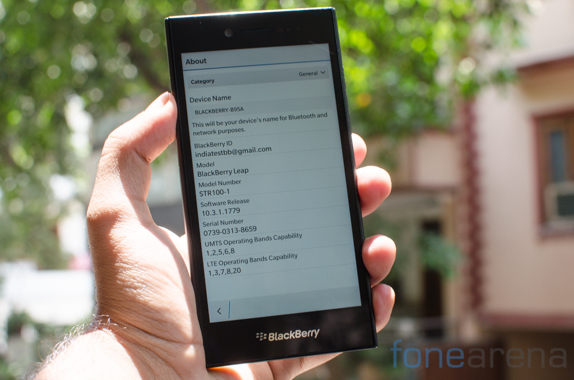
For all the interesting software additions made by BlackBerry, the app gap stills remains a persistent nag. The preloaded Amazon app store works well to bridge the gap and indeed it does bring along several popular Android applications to the BlackBerry ecosystem but certainly not enough. Missing the likes of Spotify, Instagram and the bleeding edge versions of those that are available as well, BlackBerry’s emulation of Android is not going to cut it for app junkies wishing to get their fix on BlackBerry hardware.
Performance
There’s no putting it lightly, the BlackBerry Leap’s internals are absolutely ancient but on closer scrutiny of the handset, we feel that it won’t be as big a problem as we imagined. The phone runs on the same 1.5Ghz dual core Snapdragon S4 Plus chipset as the two year old Z10. This is paired with 2GB of RAM and 16GB of storage. You’ll want to expand that via the microSD card slot.
Remember when we said that the two year old silicon in the Leap isn’t as huge a problem as we anticipated? BlackBerry aced the optimization game with the Z10 two years ago and delivered absolutely slick performance from the relatively modest internals. That fact stands true today as well. There is no lag anywhere despite the graphic intensive nature of the operating system. On occasion you might spot a hint of a lag but that too generally disappears within the second itself. Gaming is the Achilles heel of the handset but then again because of the low number of games on the platform, you’ll have other problems to worry about. Our concerns about the hardware mainly arise from the fact that you are getting two year old hardware for the price of a modern Android handset and this raises concerns about long term usability. For the moment though, the Leap’s performance is certainly satisfactory.
Camera
The BlackBerry Leap has an 8MP camera over at the rear with a single LED flash. It also has a fixed focus front facing camera. . A mainstay of the enterprise audience, there’s a better chance you’ll find someone toting a camera-less BB than one with a fantastic camera. Let’s face it, a BlackBerry device is not known for it’s photography capabilities so color us surprised when we discovered that the Leap takes not just passable but quite decent shots in practically every lighting condition. The proof is in the pudding though so we’ve included a range of camera samples below to give you a better idea of the photography capabilities of this handset.

In a normal well lit scenario, the Leap performs well. You’ll notice that the highlights are blown out in the top left corner which demonstrates the constraints related to dynamic range. Colors are quite natural and saturation levels aren’t over the top. What we definitely like here is that even sharpness levels are kept under control which ensures that images look good.
The first two images in the grid demonstrate the stark difference brought upon by the HDR mode in the camera. The software in the BlackBerry Leap is smart enough to guess that you’ll want to use a specific mode and it pops in a drop-in to enable the mode with a single tap. Low light shots are generally decent enough with noise levels in check. The lack of optical image stabilization (OIS) means that you won’t really be able to compete with the higher end camera phones but the shots are generally more than acceptable. The phone can shoot video at 1080p resolution at 30 frames per second. The only area where we felt that the camera let us down was in focussing speed. The camera was a bit unreliable with getting a focus lock and we ended up taking a few shots that were completely blurred out. Close ups proved to be hardest to get a focus on.
Display
A 5inch 720p panel is what you find on the BlackBerry Leap. For an entry level handset that’s about par for the course but the Leap is of course priced well above that tier. A Full HD panel would have been far more welcome here.
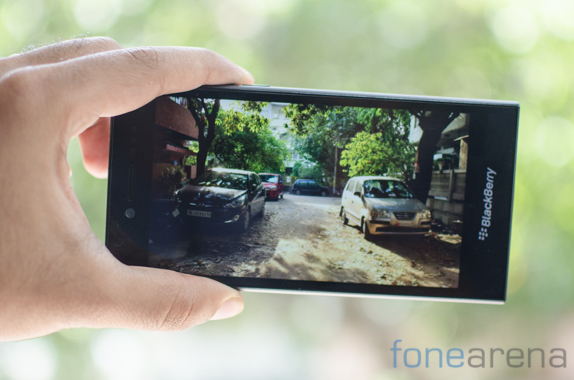
We found the display on the handset to be perfectly serviceable albeit with a few cons. The contrast ratio on the panel is very good and so are the wide viewing angles which enable multiple users to watch a video on the same screen. Unfortunately, the low-ish resolution entails spreading 1280×720 pixels across 5 inches which induces a hint of blur around the edges. Additionally, sunlight readability could be a tad bit better with the glare from the glossy display making it comparatively hard to view the screen.
Connectivity & Battery Life
The BlackBerry Leap is reasonably equipped in the connectivity department. You get WiFi b/g/n, Bluetooth 4.0 and GPS. Additionally the phone also supports Miracast for screen mirroring which somewhat makes up for the loss of the Slimport connector. The company has clearly dropped NFC support to keep cost in check. We’d have also liked to see a dual band WiFi radio and 802.11ac support. Of the 16GB of storage, just under 10GB is available at first boot. The phone is really good at RAM management and you’ll never really have to worry about it. For those who are still concerned there is close to 1.2GB of free RAM at launch and even with heavy multitasking, it rarely dips below 800MB. A 2,800 mAh battery isn’t something extraordinary. What BlackBerry has managed to eke out of it certainly is. Between a combination of just not using the phone as much as an Android device and remarkable optimization, the phone was able to last well over a day and a half of usage. No matter how much of an email addict you are, you’ll struggle to deplete the battery on this one before the day is over.
Conclusion
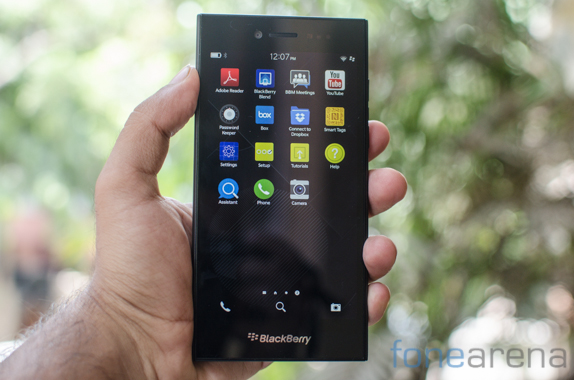
There’s nothing inherently wrong with the BlackBerry Leap. It’s a nice well rounded handset that isn’t even trying to compete with the Androids out there. To BlackBerry’s credit, they are not even aiming this handset at the consumer market. If you’re a regular user and someone who absolutely needs a new BlackBerry device in their life, sure, you can head over to a retail store to pick up one but that’s not the company’s market. This device is aimed squarely at corporate deployment as a tool for middle management to stay connected. For that purpose it certainly excels. Excellent battery life, legendary security, slick lag free performance and just enough of multimedia features to allow some down time. For the rest of us? With a price point of Rs. 21,490, the Leap competes with too many great Android handsets to hold it’s own.
Pros
- Battery Life
- Camera
Cons
- Price
- App gap




